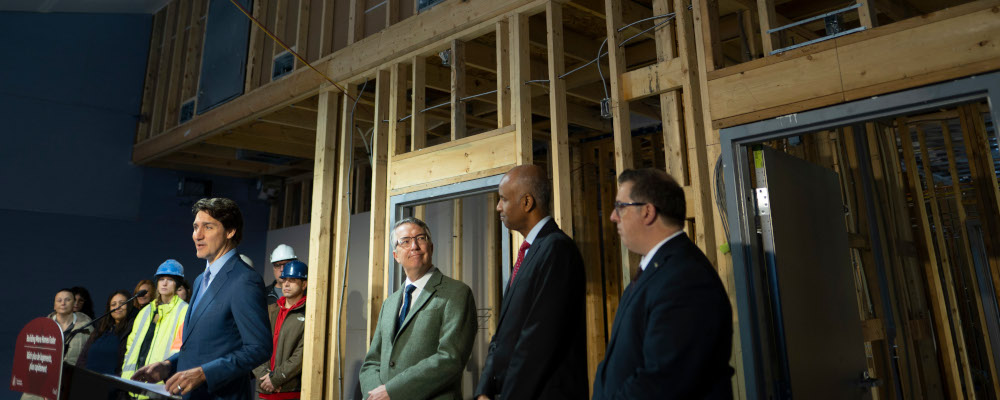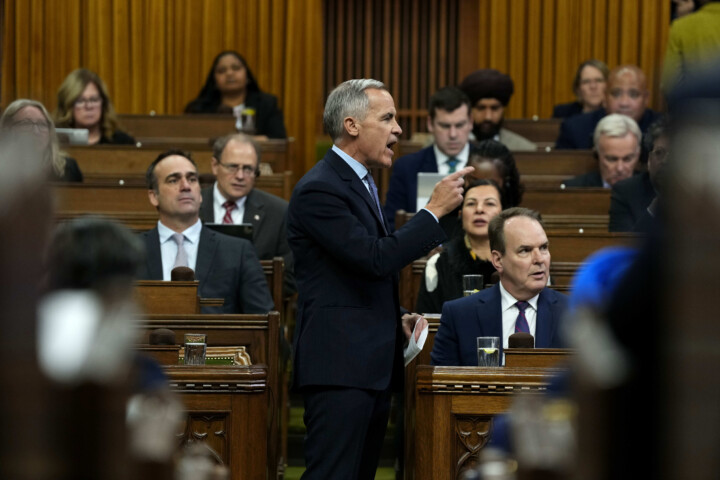We’ve all heard it before: building more condos isn’t going to solve Canada’s housing crisis—we need governments to provide affordable housing instead.
It’s the standard left-wing response to the growing consensus that Canada needs to rapidly increase housing production in order to address our housing crisis. The first part is wrong. The second part gets at something that’s often missed in housing debates.
Let me explain. When most of us talk about the housing crisis, we’re talking about the middle-class—and upper-middle class—housing crisis. Rising home prices and market rents are pricing more and more people out of our cities. It’s the crisis we see since it directly affects most of us including those in the professional class.
Crisis number one: Not enough market-rate housing
Housing crisis number one is pretty simple. Housing completions have been relatively stable for decades while population growth has increased. People try to make this complicated, blaming their preferred causes—whether it’s foreign investors, immigrants, or the whole capitalist system. In reality, it’s math.
If there aren’t enough new condos for upper-middle-class urban professionals to buy or rent, they move down market to older units. That pushes middle-class buyers down a notch on the housing ladder, and some people off entirely. At the risk of sounding simplistic, the solution to this crisis is to make the math work. In other words, we need to bring housing completions into line with population growth.
Ideally, we’d do that entirely by building more housing. If we fail to do that, we’re probably going to end up with less immigration—a lost opportunity for Canada. We can resolve housing crisis number one through slower population growth, more housing, or both. Whatever we decide, it’s a conceptually easy (though politically difficult) problem.
The standard left-wing line gets crisis number one entirely wrong. It might well be because they’re focused almost exclusively on housing crisis number two.
Crisis number two: Not enough social housing
Housing crisis number two is much more complicated. After all, some people are never going to be able to afford market-rate rents. It’s probably not a large proportion of the population—the vast majority of people are housed through the private market—but it’s the most vulnerable segment of the country. We could cut rental rates in half and some people would still be left out. Frankly, many of those people need more than just affordable housing. Some are dealing with complex addiction issues, broken families, and trauma.
It’s tempting to think that everyone can be pulled up onto their own two feet if we just give them a hand. The addict, the unemployed single parent, the domestic abuse survivor. But even if healthy housing markets around the world, some people fall through the cracks. It’s not just about cheap rent.
The Left is correct when they point out that some people will never be served by “luxury condos.” Where they err is in assuming that this is true for everyone. Building enough new homes to bump the rental vacancy rate from 1 to 3 percent, for instance, would put downward pressure on rents. Even slightly lower rent payments and more locational options would be a welcome relief to many renters. We shouldn’t discount this just because it won’t help everyone. We can walk and chew gum. We can address both housing crises.
Of course, while the Right (and centre) is correct that we need more market-rate housing to solve housing crisis number one, we haven’t done enough to address housing crisis number two. Given the magnitude of crisis number one, we absolutely should be pounding the table about it. But it’s hard to build political consensus for solving one housing crisis without addressing both.
We can’t solve one and not the other
While it’s theoretically possible to solve crisis number one without solving crisis number two, the reverse isn’t true. The bigger housing crisis number one gets, the more it spills over into crisis number two. Many people who would be able to afford 2019 market rate rents in Toronto might not be able to afford 2023 market rates. Some of them may end up part of crisis number two. Being precariously housed can push people into downward spirals that require far more than a few hundred dollars less rent.
To get a grasp of how housing crisis number one impacts housing crisis number two, consider an exercise I undertook with my colleague Josef Filipowicz recently for the Macdonald-Laurier Institute. We decided to estimate the cost of addressing Canada’s overall housing backlog through social housing alone. While there’s no perfect estimate of how many market-rate units Canada needs, let alone how many social housing units are needed. After all, there’s no objective criteria for how many social housing units are needed that doesn’t account for market rents. More people will need social housing in expensive markets like Toronto than in expensive markets like Cleveland, all else equal.
We landed on CMHC’s Core Housing Need (CHN) as our preferred indicator. Put simply, it’s a measurement of the number of people who aren’t able to afford suitable housing.

The other challenge is imputing a cost. After all, housing costs vary wildly by city and type, and context is also important. Sometimes there is publicly owned greenfield land that can easily be built on. Sometimes there’s free land, but demolition is required. Or land needs to be purchased. Moreover, overseeing a wide-scale social housing buildout would require building administrative capacity. Would that cost be in the tens of millions? Hundreds? More? It’s hard to say.
Recognizing the complexity of the issue, and in keeping with the principle of charity, we went with the lowest reasonable construction cost estimate available and left out all other costs. Then we did some simple math. Our estimated cost for construction alone: $196 to $300 billion.
Now, you might look at that number and say, that’s doable. We can simply allocate ten percent of the budget to incremental public housing every year. First of all, good luck. It’s not going to happen. Second, even if everything went right in that scenario, you’re not fully addressing crisis number two. Having a room for someone who can’t function independently isn’t enough. They often need wraparound services. That’s much harder to pay for if you’re spending billions of dollars of public money trying to house middle managers and accountants.
I’ll admit that I often roll my eyes at the standard left-wing retort that “luxury condos” (meaning normal condos) aren’t going to solve the housing crisis. But they do have a point: building more housing units isn’t enough to address everyone’s housing needs. We need to take both housing crises seriously. But we can’t even begin to address crisis number two without addressing crisis number one. We need governments to do more to help the truly vulnerable, and less that interferes with homebuilders trying to house the middle class.
Recommended for You

Carney gets a majority, but Canadians vote the Liberals out in a snap election: The Hub predicts 2026

Supply management will be sacrificed to appease Trump, and the Netflix takeover is bad for Hollywood: The Hub predicts 2026

Canada will attempt to join the EU and Justin Trudeau becomes a Katy Perry lyric: The Hub predicts 2026

I was an early supporter of B.C.’s Indigenous rights laws. Here’s why I’ve changed my mind



